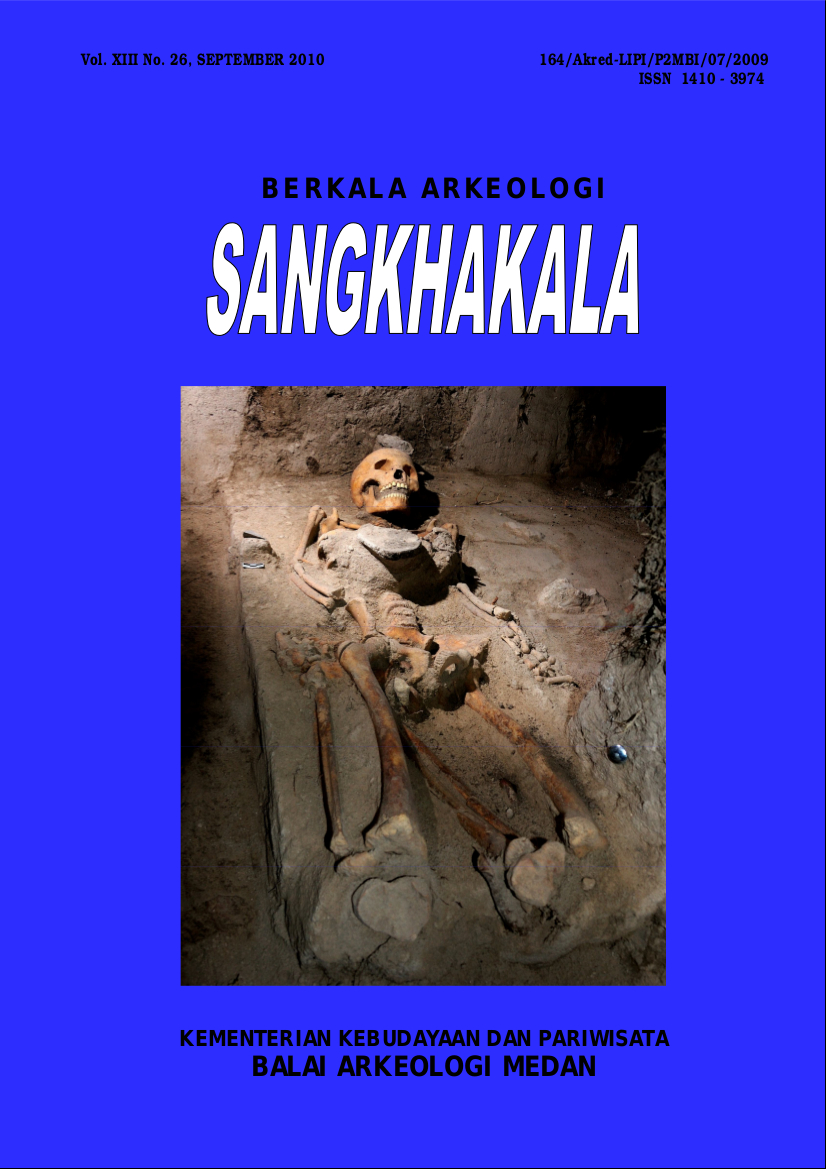Pentarikhan Baru Situs Hoabinhian dan Berbagai Kemungkinannya
Main Article Content
Abstract
Abstract
The dating often carried out through the approach on the basis of morphology and technology of the observed artifacts. While the carbon dating method is generally performed on ecofak samples found in the excavation. Determination of the dating of structure within a site is very helpful to inform the process of past activity. So, also on Hoabinhian site, the structured dating will greatly assist in the effort to understand the process of exploiting the area in the past which is also referred to chronicle events on your site. The dating is one of the methods in an attempt to reconstruct the history. Although the information generated is absolute, but it’s not yet able to disclose all aspects of the activities of the past, it’s only to provide various information that can be better.
The dating often carried out through the approach on the basis of morphology and technology of the observed artifacts. While the carbon dating method is generally performed on ecofak samples found in the excavation. Determination of the dating of structure within a site is very helpful to inform the process of past activity. So, also on Hoabinhian site, the structured dating will greatly assist in the effort to understand the process of exploiting the area in the past which is also referred to chronicle events on your site. The dating is one of the methods in an attempt to reconstruct the history. Although the information generated is absolute, but it’s not yet able to disclose all aspects of the activities of the past, it’s only to provide various information that can be better.
Downloads
Download data is not yet available.
Article Details
How to Cite
Wiradnyana, Ketut. 2018. “Pentarikhan Baru Situs Hoabinhian Dan Berbagai Kemungkinannya”. Berkala Arkeologi Sangkhakala 13 (26). Medan, Indonesia, 222-33. https://doi.org/10.24832/bas.v13i26.174.
References
Bellwood, Peter, 2000. Prasejarah Kepulauan Indo-Malaysia. Jakarta: PT. Gramedia Pustaka Utama.
Binford, L.R., 1972. An Archaeological Perspective. New York: Seminar Press
Bintarti, D.D., 1986. “Lewoleba: Sebuah Situs Masa Prasejarah di Pulau Lembata”, dalam Pertemuan Ilmiah Arkeologi IV (Jilid IIa). Jakarta: Puslit Arkenas, hlm. 73--91
Budianto,1977. Geologi Daerah Sukajadi, Payarengas dan Kampung Baru Kecamatan Hinai Kabupaten Langkat. Sumatera Utara (tidak diterbitkan)
Boedhisampurno, S, 1983. “Kerangka Manusia Dari Bukit Kelambai, Stabat, Sumatera Utara,” dalam PIA III, Jakarta: Puslit Arkenas
Forestier, Hubert, 2007. Ribuan Gunung, Ribuan Alat Batu; Prasejarah Song Keplek, Gunung Sewu, Jawa Timur. Jakarta: Gramedia
Kinnon, E. Edward, 1990. Preport on a Field Visit to Kabupaten Langkat. (tidak diterbitkan)
Kinnon, E. Edward, 1990. The Hoabinhhian in the Wampu/Lau Biang Valley of Northeastern Sumatera. Yogyakarta: An Update, IPPA
Matthews, J.M., 1964. The Hoabinhhian in South East Asia and Elsewhere. ANU
Simanjuntak, Truman dkk. (ed.), 2001. Sangiran: Man, Culture, and Environment Pleistocene Times. Jakarta: Yayasan Obor Indonesia
Soejono, R.P., 1984. Sejarah Nasional Indonesia I. Jakarta: Depdikbud
Whitten, AJ, et.al., 1984. The Ecology of Sumatera. Yogyakarta: Gajah Mada University Press
Wiradnyana, Ketut, 1997. “Model Pemukiman dan Penggunaan Kerang Masa Mesolitik di Situs Bukit
Kerang Kampung Baru, Kec. Hinai Kab. Langkat, Sumatera Utara (study awal)”, dalam Sangkhakala No 1. Medan: Balar Medan
------------------------, 2008. “Strategi Adaptasi Pengusung Hoabinhian dalam Pemenuhan Kebutuhan Makanan”, dalam Sangkhakālā Vol. XI No 22. Medan: Balai Arkeologi Medan
-------------------------, 2010. Laporan Hasil Penelitian Arkeologi Ekskavasi Situs Bukit Kerang Pangkalan, Aceh Tamiang, NAD. Medan: Balai Arkeologi Medan (belum diterbitkan)
Wiradnyana, K., Nenggih S. & Lucas.P.K, 2002. “Gua Togi Ndrawa, Hunian Mesolitik di Pulau Nias”, dalam Berita Penelitian Arkeologi No. 8. Medan: Balai Arkeologi Medan
Wissema,Gustaaf Gerard, 1947. Young Tertiary and Quaternary Gastropoda from the Island of Nias, (Malay Archipelago). Lei den: N.V. Drukkerij en Uitgevers-Mij y/h
Binford, L.R., 1972. An Archaeological Perspective. New York: Seminar Press
Bintarti, D.D., 1986. “Lewoleba: Sebuah Situs Masa Prasejarah di Pulau Lembata”, dalam Pertemuan Ilmiah Arkeologi IV (Jilid IIa). Jakarta: Puslit Arkenas, hlm. 73--91
Budianto,1977. Geologi Daerah Sukajadi, Payarengas dan Kampung Baru Kecamatan Hinai Kabupaten Langkat. Sumatera Utara (tidak diterbitkan)
Boedhisampurno, S, 1983. “Kerangka Manusia Dari Bukit Kelambai, Stabat, Sumatera Utara,” dalam PIA III, Jakarta: Puslit Arkenas
Forestier, Hubert, 2007. Ribuan Gunung, Ribuan Alat Batu; Prasejarah Song Keplek, Gunung Sewu, Jawa Timur. Jakarta: Gramedia
Kinnon, E. Edward, 1990. Preport on a Field Visit to Kabupaten Langkat. (tidak diterbitkan)
Kinnon, E. Edward, 1990. The Hoabinhhian in the Wampu/Lau Biang Valley of Northeastern Sumatera. Yogyakarta: An Update, IPPA
Matthews, J.M., 1964. The Hoabinhhian in South East Asia and Elsewhere. ANU
Simanjuntak, Truman dkk. (ed.), 2001. Sangiran: Man, Culture, and Environment Pleistocene Times. Jakarta: Yayasan Obor Indonesia
Soejono, R.P., 1984. Sejarah Nasional Indonesia I. Jakarta: Depdikbud
Whitten, AJ, et.al., 1984. The Ecology of Sumatera. Yogyakarta: Gajah Mada University Press
Wiradnyana, Ketut, 1997. “Model Pemukiman dan Penggunaan Kerang Masa Mesolitik di Situs Bukit
Kerang Kampung Baru, Kec. Hinai Kab. Langkat, Sumatera Utara (study awal)”, dalam Sangkhakala No 1. Medan: Balar Medan
------------------------, 2008. “Strategi Adaptasi Pengusung Hoabinhian dalam Pemenuhan Kebutuhan Makanan”, dalam Sangkhakālā Vol. XI No 22. Medan: Balai Arkeologi Medan
-------------------------, 2010. Laporan Hasil Penelitian Arkeologi Ekskavasi Situs Bukit Kerang Pangkalan, Aceh Tamiang, NAD. Medan: Balai Arkeologi Medan (belum diterbitkan)
Wiradnyana, K., Nenggih S. & Lucas.P.K, 2002. “Gua Togi Ndrawa, Hunian Mesolitik di Pulau Nias”, dalam Berita Penelitian Arkeologi No. 8. Medan: Balai Arkeologi Medan
Wissema,Gustaaf Gerard, 1947. Young Tertiary and Quaternary Gastropoda from the Island of Nias, (Malay Archipelago). Lei den: N.V. Drukkerij en Uitgevers-Mij y/h


